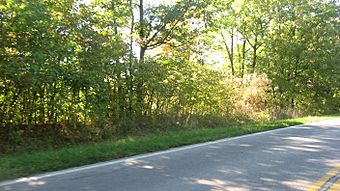Franks Site facts for kids
Quick facts for kids |
|
|
Morris-Franks Site
|
|

Woods in the portion of the site traversed by the road
|
|
| Location | Between Vermilion Rd. and the Vermilion River, southeast of central Vermilion, Ohio |
|---|---|
| Area | 87 acres (35 ha) |
| NRHP reference No. | 75001465 |
| Added to NRHP | September 5, 1975 |
The Morris-Franks Site is a very old and important place in Ohio. It's an archaeological site, which means it's a place where people lived a long time ago. This site is on high ground, called bluffs, overlooking the Vermilion River. It's near the city of Vermilion, close to where the river flows into Lake Erie.
Long ago, people from the Erie tribe lived here. Scientists have studied the site and found many clues. These clues help us learn a lot about the Erie people and how they lived.
Contents
Where is the Morris-Franks Site?
The Franks Site is located between a place called Mill Hollow and central Vermilion. It sits right on the edge of a bluff. This bluff looks over a bend in the river.
A road cuts through the site, splitting it into two main parts. There's also a third part a bit further away. Much of the area was used for campsites. But a very large part was a cemetery, where people were buried. This cemetery covers the entire third section and almost half of the other two.
The southern part of the site has curved earthworks. These are shapes made from earth on top of the bluff. Sadly, some old burials were destroyed when people built cellars for farm buildings. Others were lost when the road was built through the area.
What Was Found at the Site?
A scientist named Raymond C. Vietzen led an excavation at the Franks Site in 1941. An excavation is when archaeologists carefully dig up a site to find old things. He found many skeletons and artifacts, which are objects made by people long ago. He also found pottery.
The burials were done in different ways. Some bodies were laid out straight. Others had their legs pulled up to their chests, like they were crouching. Scientists thought these different burial styles might mean different time periods. But they found both types buried at the same time in the same areas. This showed they were from the same period.
Many adult female skeletons were found with tiny infant skeletons. This suggests that many women might have died during childbirth. It also shows that it was common to bury mothers and their babies together.
Pottery and Other Discoveries
The pottery found at the Franks Site is similar to pottery from other Erie sites. Many pots had lines carved into them. Some lines were made with antlers, which are deer horns. Other lines were thinner, made with smaller tools. There were also round or thumbnail-shaped marks.
The edges of the pottery, called rims, were often decorated. Many rims were made wider. This gave them a special look and made them stronger. It also made them easier to hold. Many decorated rims had marks pressed into them, perhaps from wood or bone. Others had notches or wavy patterns.
Archaeologists also found many animal bones. There were lots of fish skeletons, like those from sheepshead and garfish. They also found other interesting things, called features. These included postmolds, which are marks left in the ground where wooden posts once stood. They also found rubbish pits, which were ancient trash dumps.
The site is very large, and it seems many people lived there. Raymond Vietzen even said it was "far too vast to be simply classed as a village." He called it an "Erie City." He believed some artifacts were from around the year 1650. This was just a few years before the Erie people were defeated by Iroquois warriors.
The Moes Site
South of the Franks Site is a smaller place called the Moes Site. It seems to be connected to the Franks Site. The Moes Site also had a cemetery. However, it was smaller, so only ten burials were found. Most of these were infants.
Hundreds of potsherds were found. These are broken pieces of pottery. They were exactly like the pottery found at the Franks Site. The Moes Site is on the edge of a river bluff. It was named after the landowner, Isaac Moes. Vietzen reported that the site also had a burial mound. A burial mound is a hill built over graves. Moes and his family had dug up many skeletons and artifacts from this mound. One special item found was a beautiful birdstone.
Protecting the Site
After his work at the Franks Site, Raymond Vietzen wrote several books about it. He also opened a museum in Amherst. Some of the artifacts from the site were displayed there.
The Franks Site itself has been protected. This is called historic preservation. In 1975, it was added to the National Register of Historic Places. This is a list of important historical places in the United States. It was listed as the "Morris-Franks Site" because of its archaeological importance. It was the first of four archaeological sites in Lorain County to be added to this list. The others are the Burrell Fort, the Burrell Orchard Site, and the Eiden Prehistoric District.


